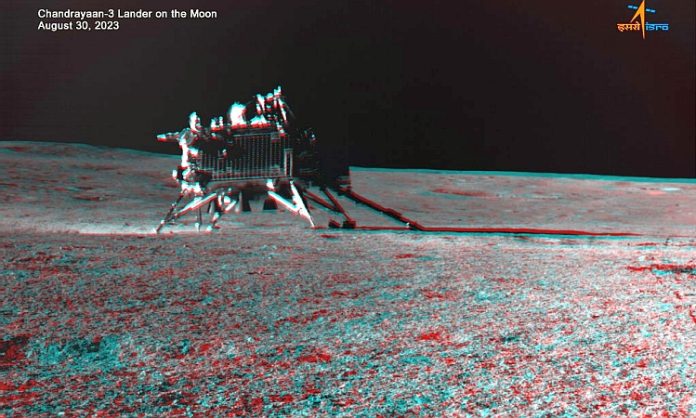Bengaluru: Indian Space Research Organisation (ISRO) seems to be losing hopes for reactivating Vikram lander and Pragyan rover, which went in a fortnight-long hibernation after the sun set on the moon’s surface on September 5.
There is no update from ISRO on the Chandrayaan-3 mission till the filing of this report, even though it had stated on Friday that it would make fresh ‘efforts to establish communication with the lander and rover to ascertain their wake-up condition after their bids failed to elicit any no signals from them.’ The space agency had added that it would continue efforts to establish contact.
Also Read: ISRO’s moon mission turns in sleep mode after lander’s hopping
On social media platform X, ISRO had posted, “Efforts have been made to establish communication with the Vikram lander and Pragyan rover to ascertain their wake-up condition. As of now, no signals have been received from them. Efforts to establish contact will continue.”
Although the mission was designed for the 14-days operation only, ISRO scientists were anticipating that the electronic and other system of the lander and rover might activate once they are exposed to the solar lights. As the Sun rose on the Moon for next fifteen days on Friday, ISRO scientists were working day and night to revive the mission.
Also Read: ISRO’s PSLV successfully places Aditya-L1 in outbound Earth orbit
A former ISRO scientist Tapan Mishra said that even if the rover fails to revive and the lander works, it will be a miracle. Some of the space scientists believed it was impossible to reactivate the exploration mission as no plastic material, no carbon power material or no electronics can survive such an extreme conditions, where temperature can go down as low as -200 degree Celsius. “At such low temperature, electronic and other plastic materials will crack. But I’m hopeful that ISRO must have done a lot of thermal management thing,” Mishra said, adding that if the equipment survived for once, it will survive many more lunar nights.
What if Vikram Lander & Pragyan rover didn’t wake up?
After putting the rover into sleep mode, ISRO had said, “The rover completed its assignments. It is now safely parked and set into sleep mode. APXS and LIBS payloads are turned off… Currently, the battery is fully charged. The solar panel is oriented to receive the light at the next sunrise expected on September 22, 2023. The receiver is kept on. Hoping for a successful awakening for another set of assignments!” The space agency had also added that if they do not wake up, “it will forever stay there as India’s lunar ambassador.”
Also Read: Chandrayaan-3’s lander reaches Moon surface, Isro creates history
Success gave us confidence to reprogramme whole mission: ISRO chief
Talking to a news channel, ISRO chief S Somanath said that it was question of the limitations and capabilities offered by the instruments. “But I am very happy that we could do this. It’s not just for demonstrating the mission. It gave the confidence to our team here who built the Chandrayaan-3 that the understanding that they got out of hop experiment is tremendous,” said the ISRO chief.
He further added that entire exercise gave them (ISRO scientists) the ability to reprogram the whole mission and to do simulation on ground to understand it so as to get remove the worries of the mind. “Everybody has the mindset of doing things which were never talked about. For exploratory mission of this nature, we must track the past which have never been travelled. And if you don’t have the courage to travel the past, you are not going to make history,” he said.
Also Read: Aditya-L1 is not a complete mission to study the Sun, says ISRO
Regarding 90kg of fuel still in the Vikram lander’s propulsion system, Somanath said it’s not like liquid fuel could be reusable. “There are possibilities that the liquid fuel might have been crystalised in such a low temperature. It might take a lot of energy to bring the liquid out of the solid state. The electronic and software system might have been corrupted at the extremely low temperatures,” added the ISRO boss.
About the Picture released by ISRO: Anaglyph is a simple visualization of the object or terrain in three dimensions from stereo or multi-view images. The Anaglyph presented here is created using NavCam Stereo Images, which consist of both a left and right image captured onboard the Pragyan Rover. In this 3-channel image, the left image is positioned in the red channel, while the right image is placed in the blue and green channels (creating cyan). The difference in perspective between these two images results in the stereo effect, which gives the visual impression of three dimensions. Red & Cyan glasses are recommended for viewing in 3D NavCam was developed by LEOS / ISRO. Data Processing is carried out by SAC / ISRO




